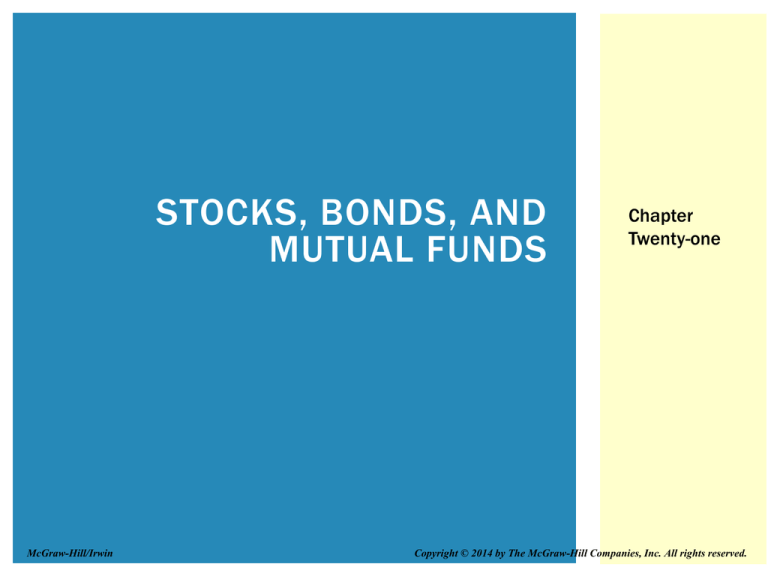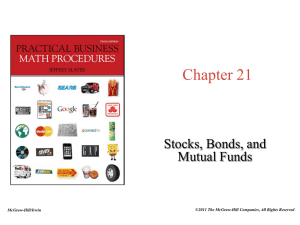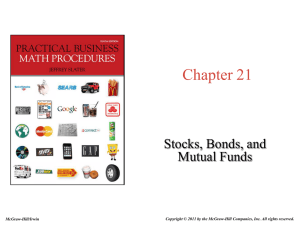
STOCKS, BONDS, AND
MUTUAL FUNDS
McGraw-Hill/Irwin
Chapter
Twenty-one
Copyright © 2014 by The McGraw-Hill Companies, Inc. All rights reserved.
LEARNING UNIT OBJECTIVES
LU21-1: Stocks
1.
Read, calculate, and explain stock quotations.
2.
Calculate dividends of preferred and common stocks; calculate return
on investment.
LU 21-2: Bonds
1.
Read, calculate, and explain bond quotations.
2.
Compare bond yields to bond premiums and
discounts.
LU 21-3: Mutual Funds
1.
Explain and calculate net asset and mutual fund commissions.
2.
Read and explain mutual fund quotations.
LU 21-4: Distribution of Profits and Losses in a Partnership
1.
Calculate distribution of profits (losses) using five methods.
21-2
STOCKS
Stock –
Common stock –
shares of ownership in a
company
stock that allows owners to have
voting rights
Preferred stock –
Dividends –
does not allow voting rights, but
gives preference over common
stockholders in dividends
payments to shareholders
from profit
21-3
STOCKS
Cumulative preferred stock –
Stockholders
entitles its owners to a specific
amount of dividends in 1 year
Elect
Board of Directors
Elect
Officers of Corporation
Dividends in arrears payments owed to
cumulative preferred
shareholders
21-4
HOW ARE STOCKS TRADED?
Stock exchanges –
an orderly trading place for
stock
Stockbrokers –
People who buy and sell stock on
the floor of the exchanges; they
charge a commission for trading
stocks
21-5
STOCK QUOTATIONS IN NEWSPAPERS
21-6
STOCK QUOTATION CALCULATIONS
Stock yield =
Annual dividend per share
Today’s closing price per share
Earnings per share =
=
Closing price
Price/Earnings ratio
$1.21
$39.09
= $39.09
17
=
3.1%
= $2.30
*Earnings per share are not listed on the stock quote.
PE ratio =
Closing price per share of stock
Annual earnings per share
=
$39.09 = 17
$2.30
21-7
DIVIDENDS ON PREFERRED AND
COMMON STOCKS
The stock records of Jason Corporation show the following:
Preferred stock issued: 20,000 shares.
In 2014, Jason paid no dividends.
Preferred stock cumulative at $.80 per share. In 2015, Jason paid $512,000 in
dividends.
Common stock issued: 400,000 shares.
2014
Dividends paid
0
Preferred stockholders
Paid:
0
Owe: 20,000 x $.80 = $16,000
Common Stockholders
0
Dividends paid
Paid for 2014
2015
$512,000
16,000
Paid for 2015
16,000
$ 32,000
Total dividend
$512,000
Paid preferred for ‘14 & ’15
32,000
To Common
$480,000
$480,000
= $1.20 per share
400,000 shares
-
21-8
CALCULATING RETURN ON INVESTMENT
Suppose you bought 200 shares of General Mills stock at $39.09 and sold them 1
year later at $41.10. With a 1% commission rate buying and selling the stock and a
current $1.21 dividend per share in effect, what was your return on investment?
Bought
200 shares at $39.09 =
$7,818.00
Commission at 1% =
78.18
Total cost
$7,896.18
Total receipt
Total cost
Net Gain
Dividends
Total Gain
$8,137.80
-7,896.18
$241.62
+ 242.00(200 x $1.21)
$483.62
Sold
200 shares at $41.10 =
Commission at 1%
=
Total receipt
$8,220
- 82.20
$8,137.80
$ 483.62
$7,896.18
6.12% rate of return
21-9
BONDS
Bonds represent a promise from the company to pay the
face amount to the bond owner at a future date, along
with interest payments at a stated rate.
When you own a stock, you own a share of a company. When you
own a bond, you are lending the company money – similar to how
banks lend money.
21-10
BOND QUOTATIONS IN NEWSPAPERS
Bonds are usually in denominations of $1,000 (the face amount).
The newspaper states bond prices in percents of face amount, not
in dollar amounts. This is the same as 99.50%.
21-11
BOND QUOTATIONS IN NEWSPAPERS
The interest on the Aflac bond is 4%. The company pays the
interest semiannually. The bond matures in 2022. The total
interest for the year is $40 (.04 x $1,000).
Yearly interest = Face value of bond x Stated yearly interest rate
$40.00
=
$1,000
x
.04
21-12
BOND QUOTATIONS IN NEWSPAPERS
Yearly interest:
Cost of bond:
=
$40.00 =
$995.00
(.04 x $1,000)
=
(.9950 x $1,000)
4.02%
This is the same as 99.50%.
21-13
CALCULATING BOND YIELDS
Bond yield =
Total annual interest of bond
Total current cost of bond at closing
Example:
Jim Smith bought 5 bonds of Aflac at the closing price of 99.50. Jim’s total cost
excluding commission is: (Remember that in dollars 99.50% is $995.)
5 x $995 = $4,975
21-14
CALCULATING BOND YIELDS
What is Jim’s interest?
No matter what Jim pays for the bonds, he will still receive interest
of $40 per bond (.04 x $1,000). Jim bought the bonds at $995
each, resulting in bond yield of 4.02%. Let’s calculate Jim’s yield to
the nearest tenth percent:
(5 bonds x $40 interest per bond per year)
$200
= 4.02%
$ 4975
21-15
WHY INVESTORS CHOOSE
MUTUAL FUNDS
Diversification
Professional management
Liquidity
Low fund expenses
Access to foreign markets
21-16
NET ASSET VALUE
Mutual fund –
a portfolio of stocks and/or bonds
Net asset value (NAV) –
the dollar value of one mutual fund share
NAV = Current market value of fund’s investment -- Current liabilities
Number of shares outstanding
21-17
COMMISSIONS WHEN BUYING
MUTUAL FUNDS
Classification
Commission charge
Offer price to buy
No-load (NL) fund
No sales charge
NAV
(Buy directly from investment company)
Low-load (LL) fund 3% or less
NAV + commission %
(Buy directly from investment company or
from a broker)
Load fund
8 ½% or less
NAV + commission %
(Buy from a broker)
21-18
HOW TO READ MUTUAL
FUND QUOTATIONS
FUND
Net
YTD
3-Yr.
% Ret
% Ret.
8.9
71.6
NAME
NAV
Chg
Grln P
13.82
-0.06
• The $13.82 figure is the NAV plus the sales commission.
• The fund has decreased $.06 from the NAV quotation of the previous day.
• The fund has a 8.9% return this year (January through May 27).
This assumes reinvestments of all distributions. Sales charges are
not reflected.
21-19
MUTUAL FUNDS
Bonnie and Pat Meyer are in their retirement years. They just
received $250,000 after taxes from the sale of their vacation
home and decided to invest the money in a bond mutual fund.
They chose a no-load mutual fund that yields 4.5%. How much
will they receive each year? How much would they need to
invest if they needed to earn $15,000 per year?
Step 1: I = PRT = $250,000 x .045 x 1 = $11,250
Step 2: P = I/RT = $15,000/(.045 X 1) = $333,333.33
If Bonnie and Pat invest $250,000, they will receive $11,250 in interest
each year. If they need to earn $15,000 in interest each year, they must
invest an additional $83,333.33:
$333,333.33 - $250,000 = $83,333.33
21-20
DISTRIBUTION OF PROFITS AND
LOSSES IN A PARTNERSHIP
Partnerships are businesses owned by two or more individuals.
Profits may be distributed many ways. We will discuss five options:
1.
2.
3.
4.
5.
Equal Share
Ratio
Original Investment
Salary and Investment
Interest on Investments and Ratio
21-21
DISTRIBUTION BY EQUAL SHARE
Profits (losses) are divided equally among the partners.
Example:
Suppose a three-partner law firm generated $72,500 in profit
the first year. Calculate the distribution based on equal share.
$72,500
= $24,166.67
3
21-22
DISTRIBUTION BY RATIO
Profits (losses) are distributed based on a prearranged
ratio.
Example:
Suppose a three-partner law firm generated $72,500 in profit
the first year and the partners agree to a 1:2:3 profit
distribution. A 1:2:3 ratio says profits (losses) will be distributed
into 1+2+3 = 6 equal shares. Now we can determine each ratio
and calculate each distribution.
Partner 1:
1
0
=
1+2+3
1
6
Partner 2:
2 0
=
1+2+3
1 x $72,500 = $24,166.67
2
=
3
6
Partner 3:
3
0
=
1+2+3
1 x $72,500 = $36,250
3
=
2
6
x $72,500 = $12,083.33
21-23
DISTRIBUTION BY ORIGINAL
INVESTMENT
The fraction of the total investment each partner invested is used to
determine the share of profit (loss).
Example:
Again, we assume a three-partner law firm generated $72,500
in profit in a year. Partner 1 originally invested $40,000, Partner
2 invested $110,000, and Partner 3 invested $150,000. First
we calculate the fraction of total investment each partner made
and then we can calculate each distribution.
Total invested: $40,000 + $110,000 + $150,000 = $300,000
Partner 1:
$40,000
x $72,500 = $9,666.67
$300,000
Partner 2:
$110,000
x $72,500 = $26,583.33
$300,000
Partner 3:
$150,000
x $72,500 = $36,250
$300,000
21-24
DISTRIBUTION BY SALARY
AND INVESTMENT
In this distribution, the fraction of the total investment each partner invested
is used to determine the share of profit (loss) minus (plus) any salaries paid.
Example:
Again, we assume a three-partner law firm generated $72,500 in
profit in a year. Partner 1 originally invested $40,000, Partner 2
invested $110,000, and Partner 3 invested $150,000. Because
Partner 3 operated the business, she earned a $50,000 annual
salary. As before, we first determine the ratio of each partner’s
investment and then calculate the distributions.
Total invested: $40,000 + $110,000 + $150,000 = $300,000
Profit minus salaries paid: $72,500 - $50,000 = $22,500
21-25
DISTRIBUTION BY SALARY
AND INVESTMENT
Example:
Again, we assume a three-partner law firm generated $72,500 in profit in a year.
Partner 1 originally invested $40,000, Partner 2 invested $110,000, and Partner 3
invested $150,000. Because Partner 3 operated the business, she earned a
$50,000 annual salary. As before, we first determine the ratio of each partner’s
investment and then calculate the distributions.
Total invested: $40,000 + $110,000 + $150,000 = $300,000
Profit minus salaries paid: $72,500 - $50,000 = $22,500
Partner 1:
$40,000
X $22,500 = $3,000
$300,000
Partner 2:
$110,000
X $22,500 = $8,250
$300,000
Partner 3:
$150,000
$300,000
X $22,500 = $11,250 + $50,000 = $61,250
21-26
DISTRIBUTION BY INTEREST ON
INVESTMENTS AND RATIO
Distribution, profits (losses) are distributed by a prearranged ratio after return
on investments have been satisfied.
Again, we will use the same information we used previously: a three-partner
law firm with $72,500 profit, where Partner 3 receives a 7% return on her
$150,000 investment.
Partner 3’s return on investment: $150,000 x .07 = $10,500
Amount available for distribution: $72,500 - $10,500 = $62,000
We know from our earlier example that a 1:2:3 ratio says profits
(losses) will be divided into 6 equal shares. We can now determine each
ratio and calculate each distribution.
Partner 1:
Partner 2:
Partner 3:
1 x $62,000 = $10,333.33
6
2 = 1 x $62,000 = $20,666.67
3
6
3 = 1 x $62,000 = $31,000 + $10,500 = $41,500
2
6
21-27










